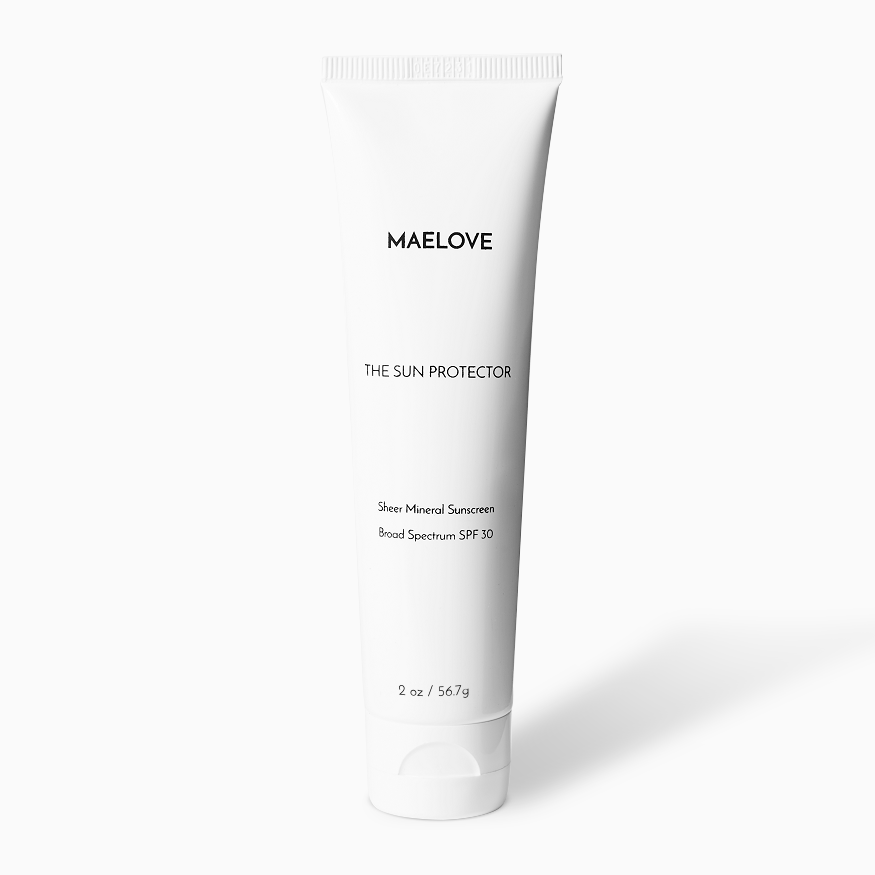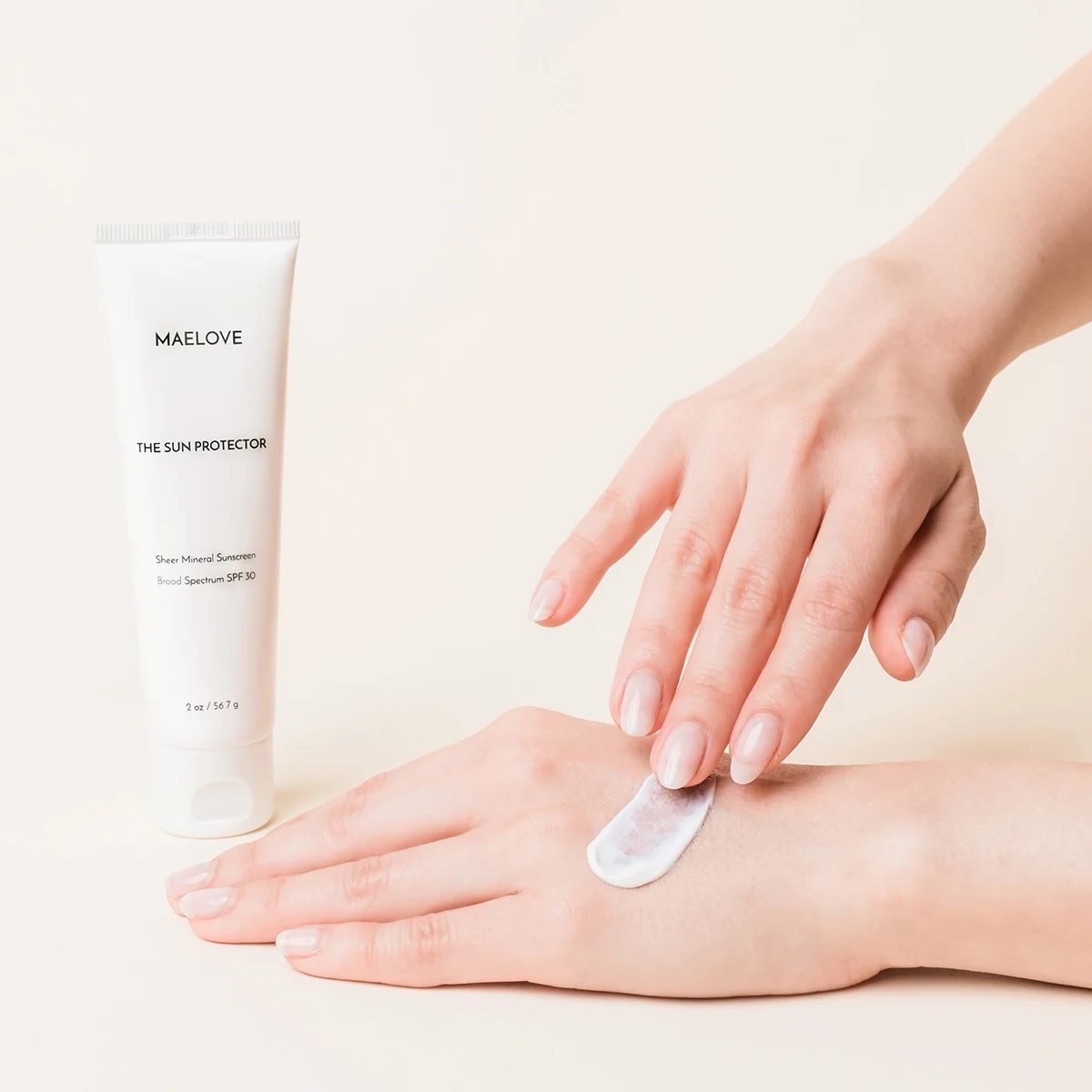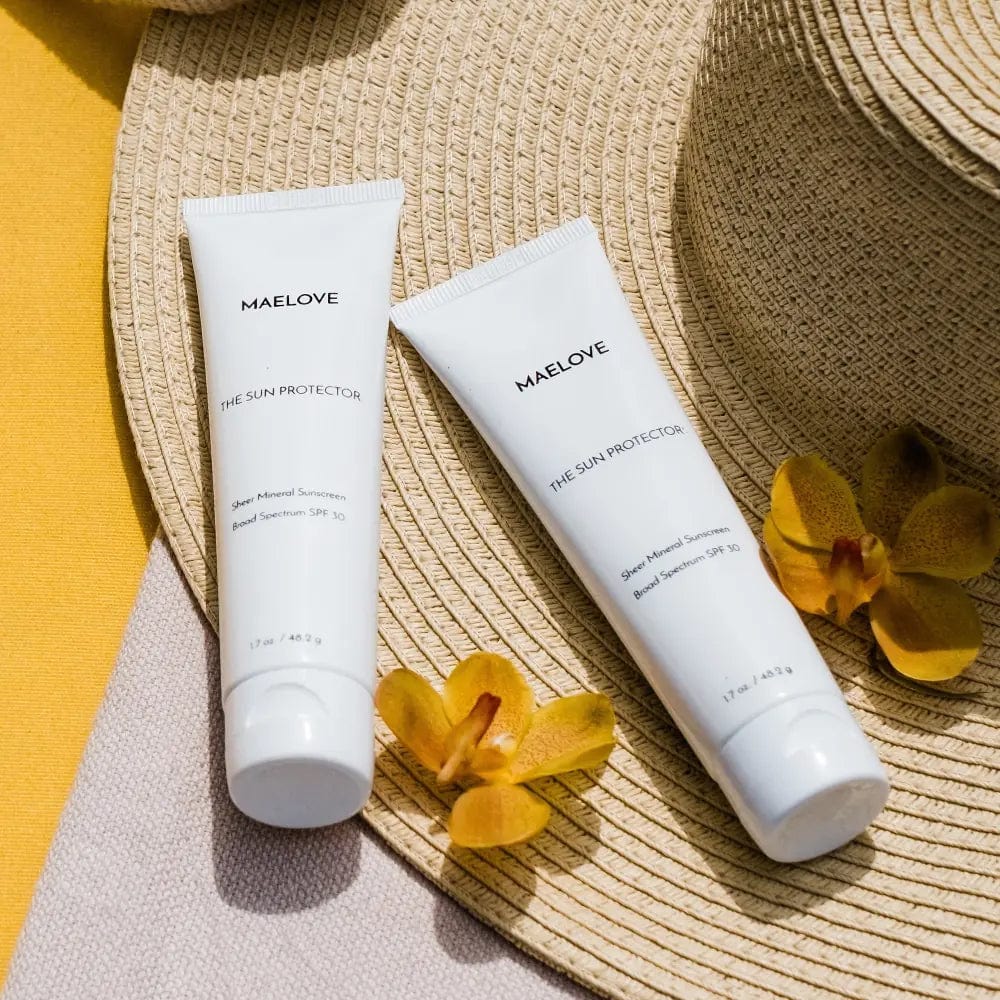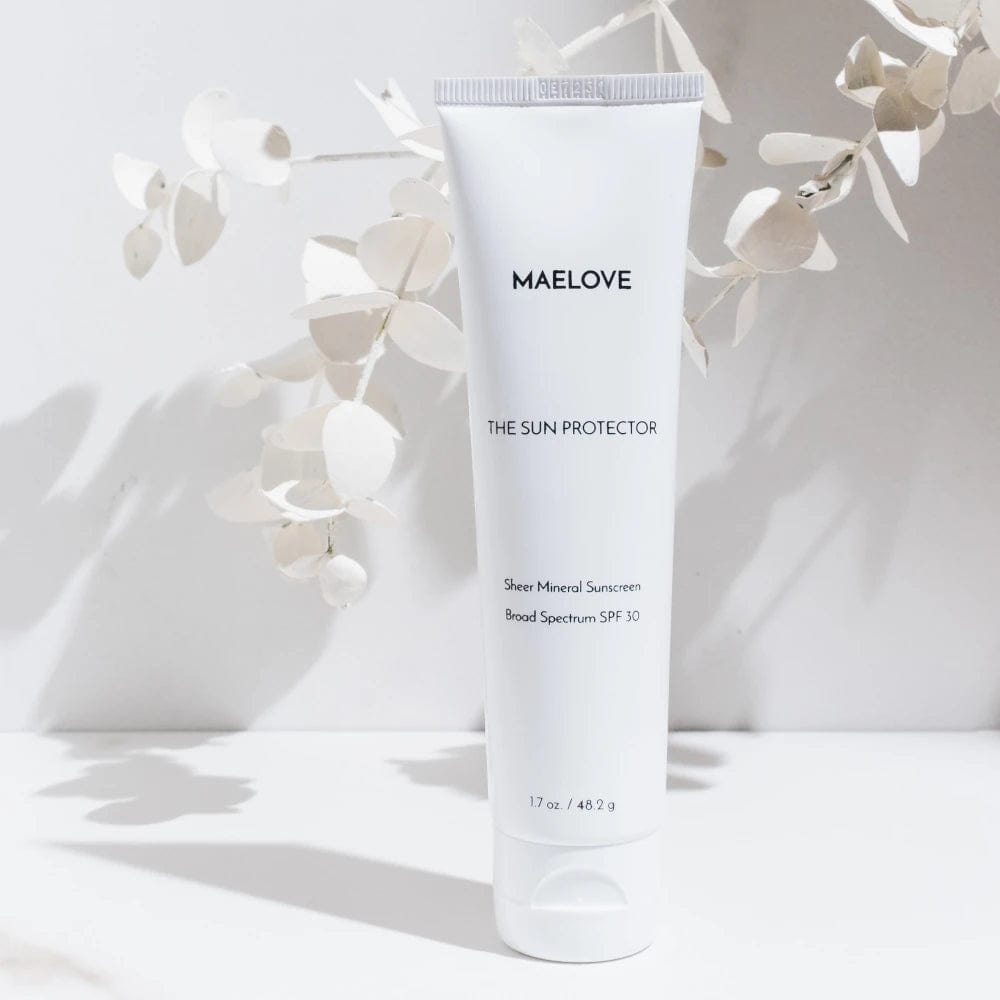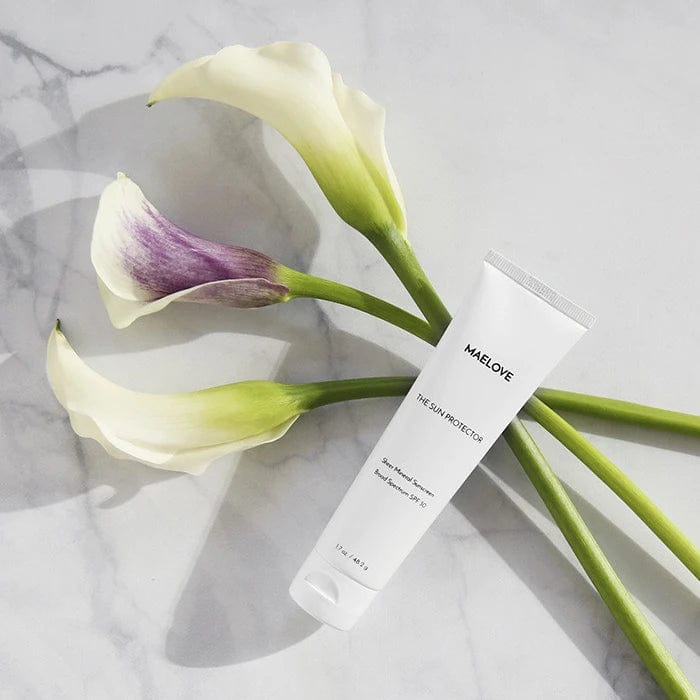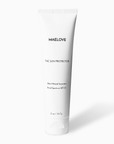
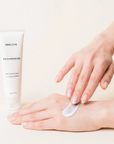
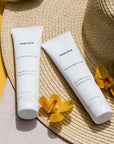
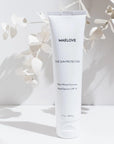
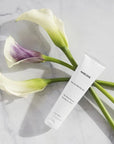
Sun Protector SPF 30 Sunscreen
We firmly stand behind the efficacy of our products, which is why we back them with an industry-leading 100-day Money Back Guarantee.
If you're not 100% happy, return the products within 100 days for a full refund. We'll even cover the return shipping. It's our commitment to ensure that you're completely satisfied with your Maelove journey.
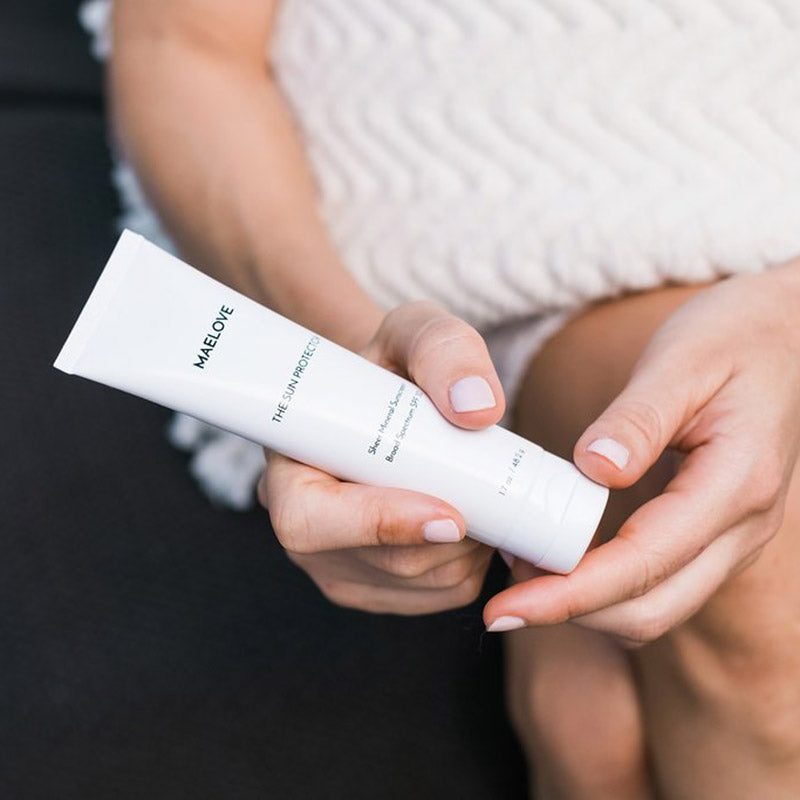
OBSESSIVELY FORMULATED
Sun Protector is a 100% mineral sunscreen that uses non-nano 18.6% zinc oxide for complete defense against UVA and UVB rays. Our non-comedogenic, hypoallergenic formula is silky smooth, light as air, and doubles as a makeup primer to simplify your morning routine.
We’ve infused this SPF with antioxidants for protection against free-radical damage and a blend of botanical extracts for extra nourishment.
Formulated without oxybenzone, avobenzone, octinoxate, homolsalate, parabens, phthalates, fragrance, and dyes, you can feel good knowing you’re protected from premature aging, hyperpigmentation, and UV-damage thanks to this daily facial sunscreen.
Broad spectrum SPF 30 protection with a 100% mineral formula
- Non-nano 18.6% zinc oxide provides defense against both UVA and UVB rays
- Free of oxybenzone, avobenzone, octinoxate, homosalate, parabens, phthalates
- Non-comedogenic and hypoallergenic formula with a light-as-air texture
Fortified with antioxidants and skin-enhancing ingredients
- Antioxidants help to protect skin from environmental stressors and prevent signs of aging
- A botanical blend soothes and calms the skin, reducing inflammation and irritation
- Nourishing botanical extracts maintain moisture levels for soft, supple skin
For AM use daily. Use as the last step in your skincare routine after serums and creams, but before makeup. Apply a thin layer to the face, neck, and chest. Massage product in until it is fully absorbed.
Key Ingredients
zinc oxide (18.6%)
Supporting Ingredients
Plankton Extract, Phoenix Dactylifera (Date) Fruit Extract, Imperata Cylindrica Root Extract, Arabidopsis Thaliana Extract, Polygonum Acivulare Extract, Ascorbic Acid, Ascorbyl Palmitate, Tocopherol
All Maelove products are safe for sensitive skin, made in the US, vegan, cruelty-free, non-comedogenic, gluten-free, and free of parabens, phthalates, dyes, and artificial fragrances. We don't use ingredients that are banned in the EU or in the USA.
Show all ingredients
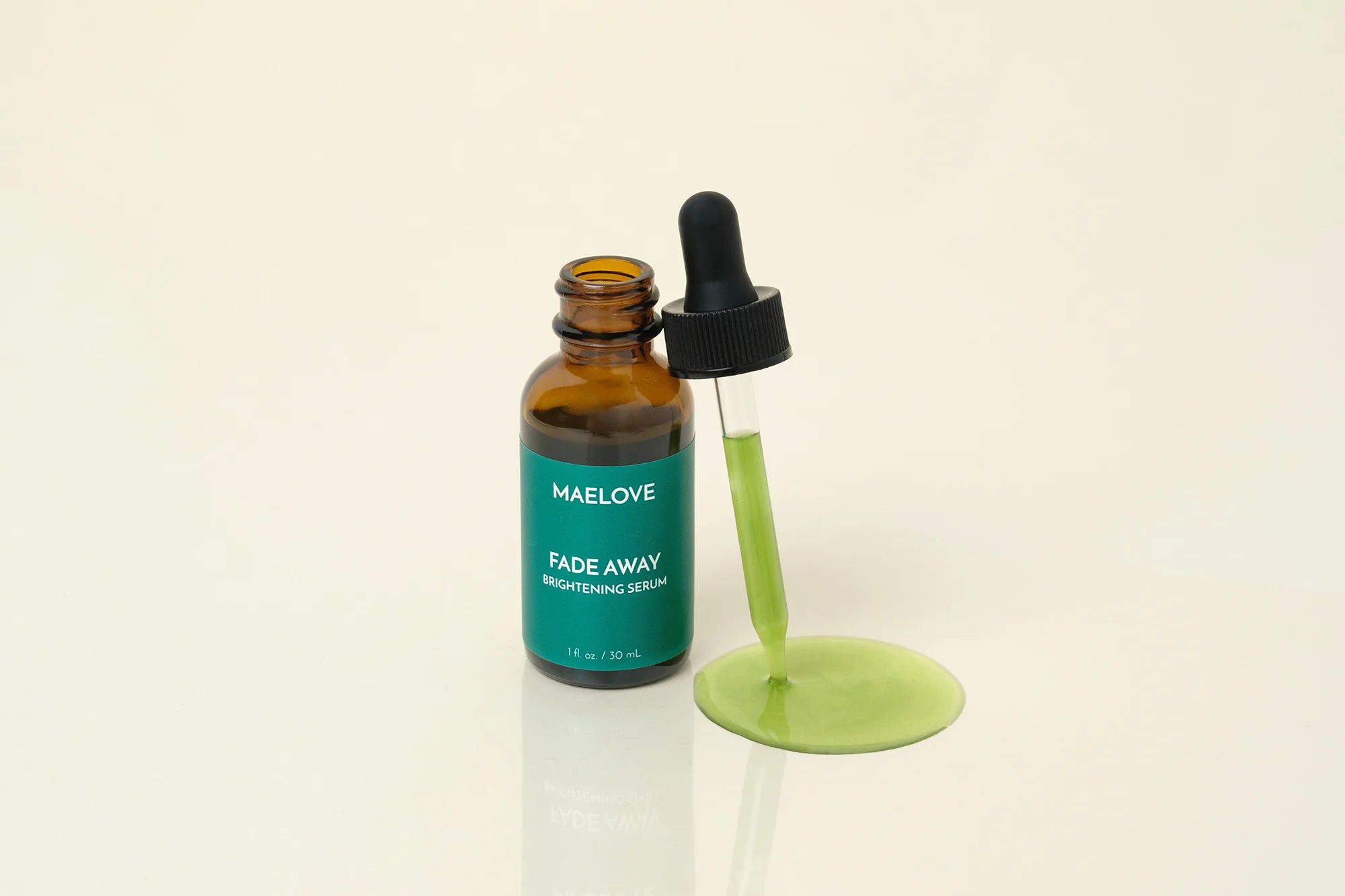
This writeup was lead-authored by our senior technical adviser, Sunbin Song, PhD. Sunbin graduated from MIT with a degree in Biology before receiving a doctorate in neuroscience from Georgetown and...
For the Curious
Approximately 80% of skin aging on the face can be attributed to ultraviolent (UV) exposure and especially in those with lighter skin, UV exposure can lead to skin cancer. For these reasons, the American Academy of Dermatologists (AAD) recommends daily use of a broad spectrum sunscreen with SPF 30 or above for optimal protection.
However what is the meaning of the terms broad spectrum and SPF? There are two types of UV rays: UVA and UVB. While UVA rays cause photo-aging of the skin, UVB rays cause sunburn. The term SPF specifically relates to protection from UVB rays that cause sunburn, rather than protection from UVA rays that cause photo-aging. SPF 30 means that it would take you 30 times longer to burn with the sunscreen than without, and an SPF 30 product blocks about 97% of UVB rays. The AAD also recommends a sunscreen that is labeled “broad-spectrum” as this specifically means that there is demonstrated protection against UVA rays as well as UVB (Guan et al. 2021, Henderson et al. 2022).
Sunscreens can either be physical with zinc oxide or titanium dioxide, or chemical with avobenzone, octinoxate, and oxybenzone amongst others. While physical sunscreens are a physical barrier that scatter or reflect UV, chemical sunscreens absorb UV rays. Chemical sunscreens absorb into the bloodstream and the long-term safety effects are unknown and hence are rated by the FDA as needing further evaluation. The FDA only rates zinc oxide and titanium dioxide as generally regarded as safe and effective (GRASE). In recent years as more people become conscious of the health ratings of skincare products particularly when pregnant or breastfeeding, physical mineral sunscreens have become more popular (Bennett and Khachemoune 2022). Of the two, zinc oxide has a broader UVA-UVB absorption curve than titanium dioxide (Schneider et al. 2019). The Sun Protector is a 100% mineral sunscreen containing 18.6% zinc oxide.
The main complaint when it comes to mineral sunscreens is that they can leave a white cast. If zinc oxide particles are made smaller (micronized) and even nano-sized, they no longer will leave a white cast. However, there are some downsides to micronized mineral sunscreens.
The first is that nano sized zinc oxide is toxic to mammalian cells. This is because it can penetrate through the cell’s covering and generate free radicals inside the cell which do damage (Liao et al. 2020). That being said, if you have a healthy skin barrier, even nanoparticles of zinc oxide do not penetrate into the skin to any significant degree avoiding this toxicity for the most part. Studies show no to minimal risk of toxicity of nano zinc oxide. However, the exception is damaged skin where a compromised skin barrier does allow the penetration of nano zinc oxide (Schneider et al. 2019). Hence, the white cast is part and parcel of a sunscreen that is safe for those with a damaged skin barrier.
The second is that along with chemical sunscreens, nano-sized zinc oxide and titanium oxide are considered toxic to coral and marine life by the National Oceanic and Atmospheric Administration and hence are not environmentally friendly (Guan et al. 2021). This being said, chemical sunscreens are considered the main drivers of harm to coral reefs and aquatic animals (Schneider et al. 2019). Nonetheless, the white cast is part and parcel of a sunscreen that is environmentally friendly.
Third, zinc oxide also protects against visible light only when it is pigmentary size and not when it is micronized. UVA rays that cause photo-aging increase enzymes involved in collagen degradation and when combined with visible light will induce increased and prolonged pigmentation (Guan et al. 2021). Hence, if you have hyperpigmentation issues, you want both protection from UVA and visible light with pigmentary size zinc oxide that leaves a white cast. In fact, the transparency of micronized mineral sunscreens is because they do not reflect visible light. In other words, the white cast and protection against visible light go hand in hand.
We recommend using both a vitamin C serum such as Glow Maker serum and sunscreen. A good broad-spectrum SPF 30 product is your first line of defense against UV rays and photoaged skin. However, even good sunscreens only block about half of the free radicals spawned from UV exposure. Antioxidant vitamin C serums help neutralize free radicals to protect your skin from harmful UV rays.
While physical sunscreens do not deplete across the day, vitamin C in the skin is quickly depleted by fighting UV damage or other free radical generating activities such as smoke and pollution throughout the day, topical vitamin C application twice a day may be useful to replenish levels when engaged in outdoors activities. Topical vitamin C and sunscreen work by differing mechanisms to protect your skin so the combination is ideal (Lin et al. 2005, Telang et al. 2013).
The Sun Protector also contains Vitamins C and E as well as plankton extract and botanicals that can offer some antioxidant protection. However, these are secondary in function and are not optimized in the way they can be in an antioxidant vitamin C serum such as the Glow Maker.
Yes you can. The Sun Protector is an 100% mineral sunscreen. The FDA only rates zinc oxide and titanium dioxide used in mineral sunscreens as generally regarded as safe and effective (GRASE). Chemical sunscreens (avobenzone, octinoxate, and oxybenzone amongst others) absorb into the bloodstream and the long-term safety effects are unknown and hence are rated by the FDA as needing further evaluation. Particularly when pregnant or breastfeeding, physical mineral sunscreens are recommended (Bennett and Khachemoune 2022). However, it is always advisable to double check skincare products and ingredients with your doctor and follow their protocol.
Guan LL, Lim HW, Mohammad TF (2021). “Sunscreens and photoaging: A review of current literature.” American Journal of Clinical Dermatology 22: 819-828.
Henderson SI, King KL, Karipidis KK, Tinker RA, Green AC (2022). “Effectiveness, compliance and application of sunscreen for solar ultraviolet radiation protection in Australia.” Public Health Research and Practice 32(1): e3212205.
Bennett SL and Khachemoune A (2022). “Dispelling myths about sunscreen.” Journal of Dermatological Treatment 33(2): 666-670.
Schneider SL, Lim HW (2019). “A review of inorganic UV filters zinc oxide and titanium dioxide.” Photodermatol Photoimmunol Photomed 35: 442-446.
Guan LL, Lim HW, Mohammad TF (2021). “Sunscreens and photoaging: A review of current literature.” American Journal of Clinical Dermatology 22: 819-828.
Liao C, Jin Y, Li Y, Tjong SC (2020). “Interactions of Zinc Oxide Nanostructures with Mammalian Cells: Cytotoxicity and Photocatalytic Toxicity.” Int J Mol Sci 21L 6305. Doi:10.3390/ijms21176305.
Schneider SL, Lim HW (2019). “A review of inorganic UV filters zinc oxide and titanium dioxide.” Photodermatol Photoimmunol Photomed 35: 442-446.
Lin FH, Lin JY, Gupta RD, Tournas JA, Burch JA, Selim MA, Monteiro-Riviere NA, Grichik JM, Zielinski J, Pinnell SR (2005). “Ferulic Acid Stabilizes a Solution of Vitamins C and E and Doubles its Photoprotection of Skin.” J Invest Dermatol 125:826-832
Telang PS (2013). “Vitamin C in Dermatology.” Indian Dermatol Online J. 4(2): 143-146.
Bennett SL and Khachemoune A (2022). “Dispelling myths about sunscreen.” Journal of Dermatological Treatment 33(2): 666-670.
